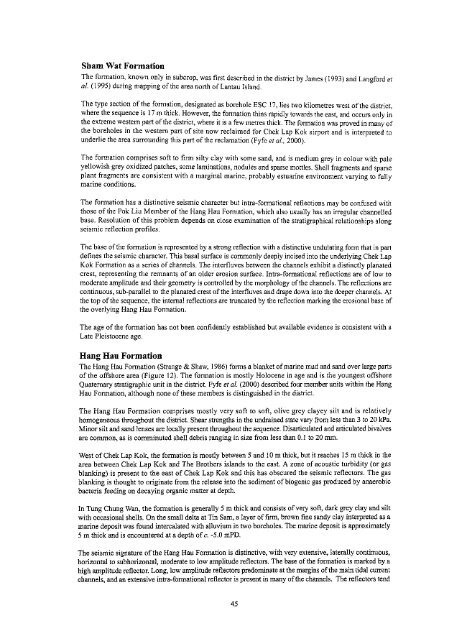5 - HKU Libraries - The University of Hong Kong
5 - HKU Libraries - The University of Hong Kong
5 - HKU Libraries - The University of Hong Kong
Create successful ePaper yourself
Turn your PDF publications into a flip-book with our unique Google optimized e-Paper software.
Sham Wat Formation<strong>The</strong> formation, known only in subcrop, was first described in the district by James (1993) and Langford etal. (1995) during mapping <strong>of</strong> the area north <strong>of</strong> Lantau Island.<strong>The</strong> type section <strong>of</strong> the formation, designated as borehole ESC 17, lies two kilometres west <strong>of</strong> the district,where the sequence is 17 m thick. However, the formation thins rapidly towards the east, and occurs only inthe extreme western part <strong>of</strong> the district, where it is a few metres thick. <strong>The</strong> formation was proved in many <strong>of</strong>the boreholes in the western part <strong>of</strong> site now reclaimed for Chek Lap Kok airport and is interpreted tounderlie the area surrounding this part <strong>of</strong> the reclamation (Fyfe et al, 2000).<strong>The</strong> formation comprises s<strong>of</strong>t to firm silty clay with some sand, and is medium grey in colour with paleyellowish grey oxidized patches, some laminations, nodules and sparse mottles. Shell fragments and sparseplant fragments are consistent with a marginal marine, probably estuarine environment varying to fullymarine conditions.<strong>The</strong> formation has a distinctive seismic character but intra-formational reflections may be confused withthose <strong>of</strong> the Pok Liu Member <strong>of</strong> the Hang Hau Formation, which also usually has an irregular channelledbase. Resolution <strong>of</strong> this problem depends on close examination <strong>of</strong> the stratigraphical relationships alongseismic reflection pr<strong>of</strong>iles.<strong>The</strong> base <strong>of</strong> the formation is represented by a strong reflection with a distinctive undulating form that in partdefines the seismic character. This basal surface is commonly deeply incised into the underlying Chek LapKok Formation as a series <strong>of</strong> channels. <strong>The</strong> interfluves between the channels exhibit a distinctly planatedcrest, representing the remnants <strong>of</strong> an older erosion surface. Intra-formational reflections are <strong>of</strong> low tomoderate amplitude and their geometry is controlled by the morphology <strong>of</strong> the channels. <strong>The</strong> reflections arecontinuous, sub-parallel to the planated crest <strong>of</strong> the interfluves and drape down into the deeper channels. Atthe top <strong>of</strong> the sequence, the internal reflections are truncated by the reflection marking the erosional base <strong>of</strong>the overlying Hang Hau Formation.<strong>The</strong> age <strong>of</strong> the formation has not been confidently established but available evidence is consistent with aLate Pleistocene age.Hang Hau Formation<strong>The</strong> Hang Hau Formation (Strange & Shaw, 1986) forms a blanket <strong>of</strong> marine mud and sand over large parts<strong>of</strong> the <strong>of</strong>fshore area (Figure 12). <strong>The</strong> formation is mostly Holocene in age and is the youngest <strong>of</strong>fshoreQuaternary stratigraphic unit in the district. Fyfe et al (2000) described four member units within the HangHau Formation, although none <strong>of</strong> these members is distinguished in the district.<strong>The</strong> Hang Hau Formation comprises mostly very s<strong>of</strong>t to s<strong>of</strong>t, olive grey clayey silt and is relativelyhomogeneous throughout the district. Shear strengths in the undrained state vary from less than 3 to 20 kPa.Minor silt and sand lenses are locally present throughout the sequence. Disarticulated and articulated bivalvesare common, as is comminuted shell debris ranging in size from less than 0.1 to 20 mm.West <strong>of</strong> Chek Lap Kok, the formation is mostly between 5 and 10 m thick, but it reaches 15 m thick in thearea between Chek Lap Kok and <strong>The</strong> Brothers islands to the east. A zone <strong>of</strong> acoustic turbidity (or gasblanking) is present to the east <strong>of</strong> Chek Lap Kok and this has obscured the seismic reflectors. <strong>The</strong> gasblanking is thought to originate from the release into the sediment <strong>of</strong> biogenic gas produced by anaerobicbacteria feeding on decaying organic matter at depth.In Tung Chung Wan, the formation is generally 5 m thick and consists <strong>of</strong> very s<strong>of</strong>t, dark grey clay and siltwith occasional shells. On the small delta at Tin Sam, a layer <strong>of</strong> firm, brown fine sandy clay interpreted as amarine deposit was found intercalated with alluvium in two boreholes. <strong>The</strong> marine deposit is approximately5 m thick and is encountered at a depth <strong>of</strong> c. -5.0 mPD.<strong>The</strong> seismic signature <strong>of</strong> the Hang Hau Formation is distinctive, with very extensive, laterally continuous,horizontal to subhorizontal, moderate to low amplitude reflectors. <strong>The</strong> base <strong>of</strong> the formation is marked by ahigh amplitude reflector. Long, low amplitude reflectors predominate at the margins <strong>of</strong> the main tidal currentchannels, and an extensive intra-formational reflector is present in many <strong>of</strong> the channels. <strong>The</strong> reflectors tend45

















